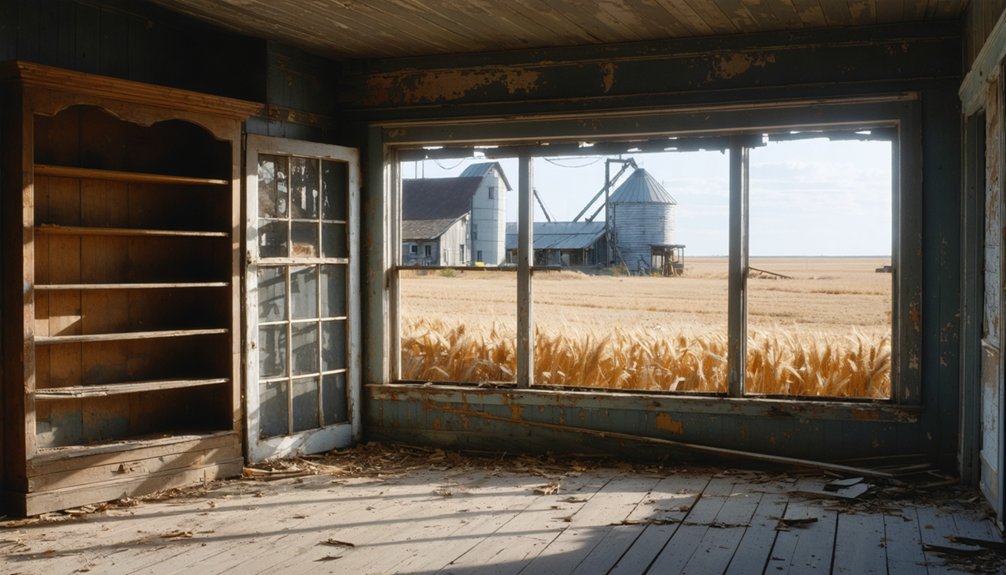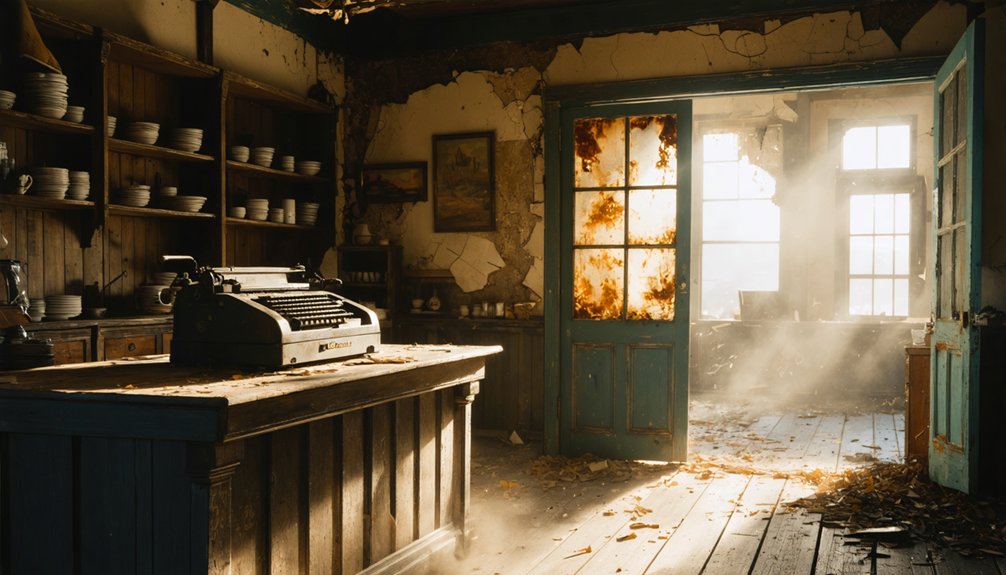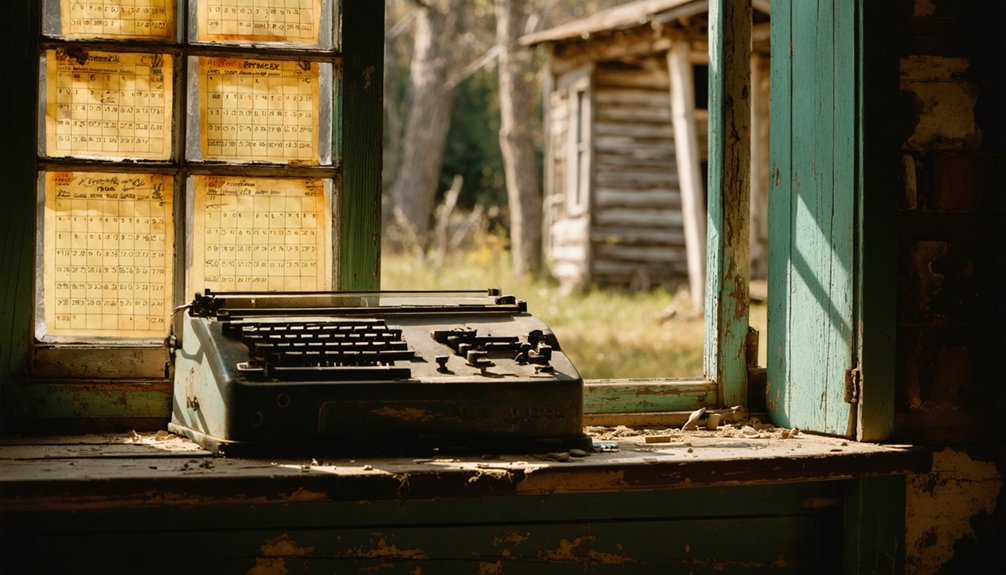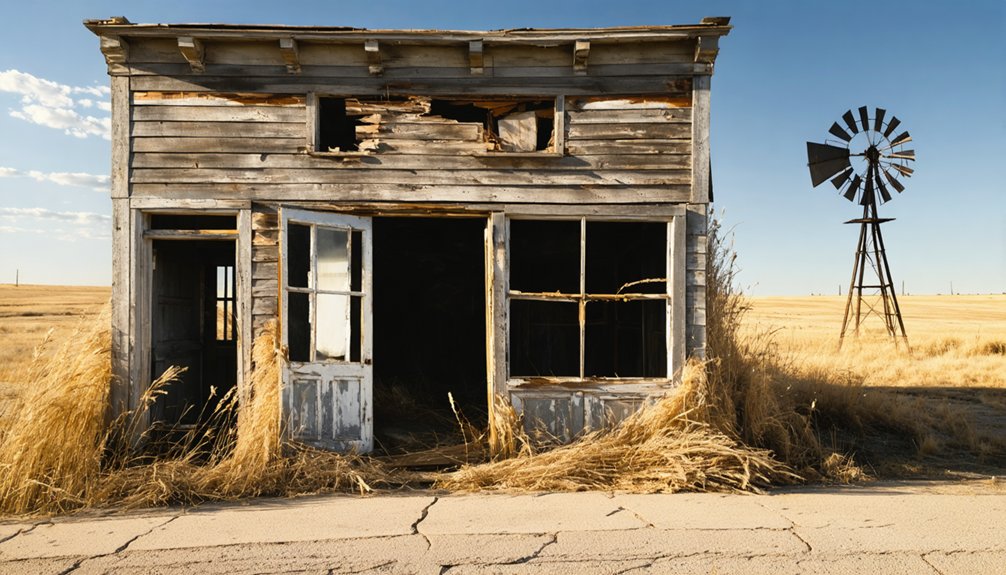You’ll find Deermont tucked away in South Dakota’s Black Hills region, where it emerged as a bustling railroad town in 1886. The town thrived through grain shipping and mining support operations, featuring hotels, churches, and a busy main street. Today, only a weathered grain elevator and concrete church foundation remain as silent sentinels of this once-vibrant prairie community. Its story mirrors countless other western settlements that rose and fell with America’s frontier dreams.
Key Takeaways
- Deermont was established in 1886 with the arrival of the railroad, becoming a vital agricultural shipping hub in South Dakota.
- The town’s primary economic activities centered around agriculture, with grain elevators and warehouses supporting regional farming operations.
- Notable structures included two churches, the Kappa Hotel, a community hall, newspaper office, bank, and schoolhouse during its peak.
- The discontinuation of railroad service and agricultural mechanization led to Deermont’s decline and eventual abandonment.
- Today, the weathered grain elevator and concrete church foundation remain as the primary visible remnants of this ghost town.
The Rise of a Black Hills Settlement
While the Black Hills had been sacred territory to numerous Native American tribes for generations, particularly the Lakota who called it *Ȟe Sápa*, the discovery of gold in 1874 during Custer’s expedition transformed the region virtually overnight.
You’d have witnessed an unprecedented rush as more than 25,000 prospectors flooded the area within two years, defying the 1868 Fort Laramie Treaty that had designated this land as unceded Indian territory.
Major settlements quickly emerged, with mining towns like Deadwood, Central City, and Lead sprouting up across the Black Hills. The towns were built upon the Deadwood Formation, where rich deposits of gold were first discovered.
The U.S. government’s subsequent actions – forcing treaty renegotiations, then unilaterally voiding tribal protections through the 1877 Manypenny Agreement – cleared the way for permanent settlement and mining operations that would extract roughly 10% of the world’s gold supply. This legal maneuver effectively employed a sell or starve policy by threatening to cut off Sioux rations.
Railroad’s Role in Town Development
Just as the Black Hills gold rush transformed western South Dakota, the arrival of the railroad in fall 1886 sparked Deermont’s birth and rapid development. The railroad influence shaped every aspect of the town’s planning, from the initial survey by engineers to the strategic placement of crucial buildings along the tracks. Similar to how local speculators invested heavily in promising railroad routes, Deermont’s founders were eager to capitalize on the rail connection.
The railroad’s 1886 arrival birthed Deermont, with its influence extending from initial planning to the strategic positioning of buildings.
The town’s first depot hotel was built by Mrs. Reynolds to accommodate railroad workers and travelers.
Key impacts of the railroad on Deermont’s development:
- Established the town’s economic foundation through grain elevators and warehouses
- Created a critical communications hub with telegraph services and mail delivery
- Attracted rapid population growth by improving transportation access
- Served as the community’s social center, with the depot hotel becoming a gathering spot
As automobiles gained popularity after World War II, Deermont’s dependence on rail transportation proved to be its undoing. The eventual abandonment of the rail line marked the beginning of the town’s decline.
Peak Years and Economic Activities

Although specific records of Deermont’s peak years remain scarce, the town’s economic activities aligned closely with other South Dakota ghost towns of the era.
Like its neighbors, you’d have found agricultural practices driving much of the local economy, with livestock operations and farming playing central roles in the community’s development.
The town experienced economic fluctuations typical of the region, likely influenced by the broader Black Hills area’s mining boom and the eventual shift from rail to road transportation.
You’ll recognize familiar patterns of decline that affected many rural South Dakota communities: technological advancements reduced the need for agricultural labor, younger residents moved toward urban opportunities, and changing market conditions reshaped the economic landscape. The decline accelerated as trucking replaced railroads for shipping agricultural goods and other materials.
Environmental challenges and shifts in farming technologies further impacted the town’s sustainability, much like Ardmore’s population dwindled to just 16 residents by 1980 due to agricultural changes.
Daily Life in Early Deermont
When settlers first established Deermont in South Dakota’s Black Hills region, their daily lives centered around modest wood-frame homes equipped with essential features like root cellars and coal-burning stoves.
Daily routines revolved around farming, livestock care, and seasonal work, while community events brought people together at churches and schoolhouses. Similar to how Barnard’s population grew to fifty by 1920, Deermont saw steady growth in its early years.
From dawn to dusk, settlers worked the land and tended animals, finding unity through gatherings that strengthened their rural community bonds.
You’ll find these core aspects defined early Deermont living:
- Self-sufficiency through subsistence farming, hunting, and food preservation
- Railroad-dependent transportation and communication systems
- Social connections maintained through religious services, fairs, and town meetings
- Shared labor during critical seasons, with neighbors helping neighbors
Life demanded early rising, hard work, and cooperation among townsfolk. Like many towns such as Awanka, they relied heavily on the grain elevator business.
You’d spend your days tending crops, trading at local markets, or working town-based jobs like blacksmithing or teaching.
Notable Buildings and Landmarks
Remnants of Deermont’s vibrant past still dot the landscape through its historic structures.
You’ll find two abandoned churches – Methodist and Catholic – that once hosted community gatherings, their architectural styles typical of early 20th-century rural South Dakota. The notable Kappa Hotel, known for its mineral bath treatments, stands alongside another hotel, both testifying to the town’s tourism appeal.
The town’s civic center included a community hall, newspaper office, bank, and schoolhouse, showcasing Deermont’s self-sustaining nature.
Along the main street, you can spot various commercial buildings in different states of preservation, some still privately owned. A local museum since 1948 provides visitors glimpses into the area’s rich history.
While specific industrial structures aren’t documented, the town’s location in the Black Hills region suggests possible mining-related infrastructure, similar to neighboring ghost towns.
Local Industries and Commerce
In Deermont’s early days, you’d find the railroad serving as the economic backbone of the community, with regular shipments of agricultural products and mining materials moving through its station.
The town’s strategic location near the Black Hills made it a natural hub for extracting and processing valuable minerals, including coal and lime from nearby quarries. Like the historic wooden grain elevator in Okaton, Deermont’s industrial structures now stand as silent reminders of its prosperous past.
Mining operations provided steady employment for local residents until technological advances and changing market demands led to the industry’s eventual decline.
Railroad Shipping Operations
Following the railroad’s arrival in 1886, Delmont rapidly developed into a bustling shipping hub for agricultural commerce throughout the region. The railroad operations transformed this small town into an essential transportation center, where grain elevators and warehouses lined the railroad sidings.
Local farmers brought their wheat and flax for shipping, while merchants received supplies through the depot’s efficient shipping logistics system.
Key aspects of Delmont’s railroad shipping:
- The depot served as the nerve center for telegrams and package handling
- Multiple grain elevators collected and stored crops before rail transport
- Agricultural products reached distant markets faster than traditional wagon routes
- The shipping infrastructure supported regional trade beyond Delmont’s immediate borders
You’ll find that Delmont’s prosperity was directly tied to these rail connections until post-WWII, when truck transportation began dominating the landscape.
Mining and Resource Extraction
Though Deermont’s primary economy centered on agriculture, the town maintained connections to South Dakota’s burgeoning mining industry through its rail links to the Black Hills region.
You’d find that Deermont’s rail connection played a crucial role in supporting the region’s gold mining operations, particularly those around Lead and Deadwood where the Homestake Mine dominated from 1876 onward.
The town’s railroad helped transport essential mining supplies and equipment needed for the deep shaft mining that reached depths beyond 6,800 feet.
While Deermont itself didn’t have active mines, it benefited from the economic growth generated by the Black Hills mining boom, serving as a transit point for the industry that transformed from simple placer operations to sophisticated hard rock mining using advanced techniques like cyanidization and mercury amalgamation.
The Path to Abandonment

While many South Dakota ghost towns share similar stories of decline, Deermont’s path to abandonment reflects the broader economic and social shifts that transformed America’s rural landscape. The major abandonment triggers emerged as transportation networks evolved, with the shift from rail to trucking dealing a devastating blow to the town’s livestock shipping economy.
- Railroad service discontinuation severed Deermont’s crucial lifeline to markets and supplies.
- Mining and quarrying operations closed, eliminating primary employment sources.
- Agricultural mechanization reduced the need for local labor, driving out younger workers.
- Community decline accelerated as essential services like post offices and schools shuttered.
You’ll find Deermont’s story mirrors the fate of many rural communities that couldn’t adapt to changing economic realities, leaving behind empty buildings as evidence of a vanished way of life.
Surviving Structures Today
You’ll find the weathered grain elevator still standing as Deermont’s most prominent remaining structure, its wooden frame silhouetted against the South Dakota sky.
The concrete foundation of the town’s historic church remains visible through prairie grass, marking where the congregation once gathered.
These surviving elements offer clear evidence of Deermont’s past as a functioning community, even as most other buildings have disappeared entirely from the landscape.
Grain Elevator Remains Standing
The towering wooden grain elevator remains one of Deermont’s most prominent surviving structures today, standing over 100 feet tall as a symbol of South Dakota’s agricultural heritage.
You’ll find the classic elevator architecture intact, with its sturdy timber cribbing resisting decades of weathering while preserving the internal grain handling systems that once kept this agricultural hub running.
- Original mechanical features, including conveyor legs and pulley systems, remain visible inside the structure.
- The elevator’s strategic position near former railway lines shows its essential role in grain transport.
- Despite exposure to harsh elements, the robust wood crib construction continues to prevent collapse.
- Internal bin systems and numbered control mechanisms offer glimpses into historic grain distribution methods.
Historic Church Foundation Visible
Remnants of Deermont’s historic church lie partially visible through scattered stone and concrete fragments marking its original foundation.
You’ll find these weathered remains hinting at the church architecture that once served as the heart of this prairie community. While time and the elements have taken their toll, these foundational stones tell the story of countless community gatherings, from Sunday services to social events that brought settlers together.
Like many ghost town structures, the church’s remains face ongoing erosion from South Dakota’s harsh weather patterns.
Though specific details about the building’s original appearance aren’t documented, archaeological evidence suggests it followed typical frontier church designs.
Today, these humble ruins stand as a symbol of Deermont’s former significance, offering researchers and history enthusiasts valuable insights into early settlement life.
Tales From Former Residents

While exploring Deermont’s history through oral accounts, former residents paint a vivid picture of daily life in this once-thriving Black Hills community.
You’ll find their stories intertwined with ghost stories and community legends that speak of railroad workers, cattle drivers, and quarry laborers who shaped the town’s identity. The economic backbone relied heavily on natural resource extraction, with lime and sandstone quarries supporting regional mining operations.
- Former residents recall the town’s decline following the removal of railroad tracks and the shift from rail to truck transportation.
- Social gatherings and community events persisted despite mounting economic challenges.
- Many families were forced to relocate when agricultural conditions worsened during the “dry years.”
- The town’s remaining physical remnants, like cattle pens and quarry ruins, serve as tangible connections to its vibrant past.
Preservation Efforts and Historical Significance
Despite lacking formal preservation programs, Deermont’s historical legacy survives through community efforts and documentation by regional historians.
You’ll find that preservation challenges include private ownership restrictions and natural decay of remaining structures, while limited funding hampers organized conservation activities.
Like other Black Hills ghost towns, Deermont emerged during the railroad era, reflecting the region’s boom-and-bust cycles. The town’s remnants tell stories of pioneer life, agricultural endeavors, and transportation-driven development that shaped South Dakota’s history.
Community initiatives, such as annual reunions in nearby ghost towns, help maintain historical consciousness and preserve local stories. While physical preservation remains minimal, historical societies continue documenting these sites through articles and media, ensuring that Deermont’s contribution to South Dakota’s cultural heritage isn’t forgotten.
Frequently Asked Questions
Are There Any Documented Paranormal Activities or Ghost Stories From Deermont?
You won’t find documented ghost sightings or paranormal investigations from Deermont. Unlike other Black Hills ghost towns, there’s no official record of supernatural activity in this former railroad and cattle town.
What Indigenous Tribes Originally Inhabited the Area Before Deermont’s Establishment?
Like ancient footprints in time, the Sioux Nation – primarily Lakota and Dakota peoples – left their cultural heritage on these lands, hunting buffalo and maintaining seasonal settlements before European-American homesteaders arrived.
How Accessible Is Deermont to Visitors Today by Car?
You’ll need a high-clearance vehicle to navigate the unpaved roads, as there aren’t any visitor amenities or maintained paths. Road conditions are rough, and weather often makes access challenging or impossible.
Were Any Famous Outlaws or Historical Figures Known to Visit Deermont?
You won’t find any confirmed famous visitors or outlaw legends in Deermont’s history. Unlike nearby Deadwood, where Wild Bill Hickok and Calamity Jane roamed, no documented evidence links historical figures here.
What Natural Disasters Significantly Impacted the Town During Its Existence?
You’ll find devastating flood impacts wreaked havoc on railroad infrastructure and sawmills, while droughts destroyed cattle grazing lands. Harsh winters isolated the town, and the 1918 influenza pandemic claimed numerous lives.
References
- https://blackhillsvisitor.com/learn/owanka/
- https://www.sdpb.org/rural-life-and-history/2023-08-21/some-black-hills-ghost-towns-and-their-origins
- https://www.powderhouselodge.com/black-hills-attractions/fun-attractions/ghost-towns-of-western-south-dakota/
- https://www.sdhspress.com/journal/south-dakota-history-2-2/some-black-hills-ghost-towns-and-their-origins/vol-02-no-2-some-black-hills-ghost-towns-and-their-origins.pdf
- https://www.youtube.com/watch?v=_0WNYsFLSLA
- https://aberdeenmag.com/2019/01/the-ghost-towns-of-brown-county/
- https://icatchshadows.com/okaton-and-cottonwood-a-photographic-visit-to-two-south-dakota-ghost-towns/
- https://en.wikipedia.org/wiki/List_of_ghost_towns_in_South_Dakota
- https://www.youtube.com/watch?v=De3wGn9KDkg
- https://en.wikipedia.org/wiki/Seizure_of_the_Black_Hills



